Plaza de Espana, Seville: a marvelous display of art and architecture
This gorgeous plaza and structure that commands an impressive view and look into Sevilla’s grand past marks the Stunning Plaza De Espana, Seville. The historic landmark in Seville was originally built for the 1929 worlds fair held in this city and was later developed into an expansive area of parks, boulevards and public monuments for the public to enjoy. The building designed by Anibal Gonzales is a mixture of the Moorish neo – mudejar style with 1920’s art deco which was very popular during that time frame.
Being a ceramics and mosaics fan, I wanted to explore all the wonderful details and tile work that is showcased in this magnificent building and check out all the details and craftsmanship involved and displayed in many areas of this structure. It’s definitely a masterpiece of ceramics and painted surfaces.
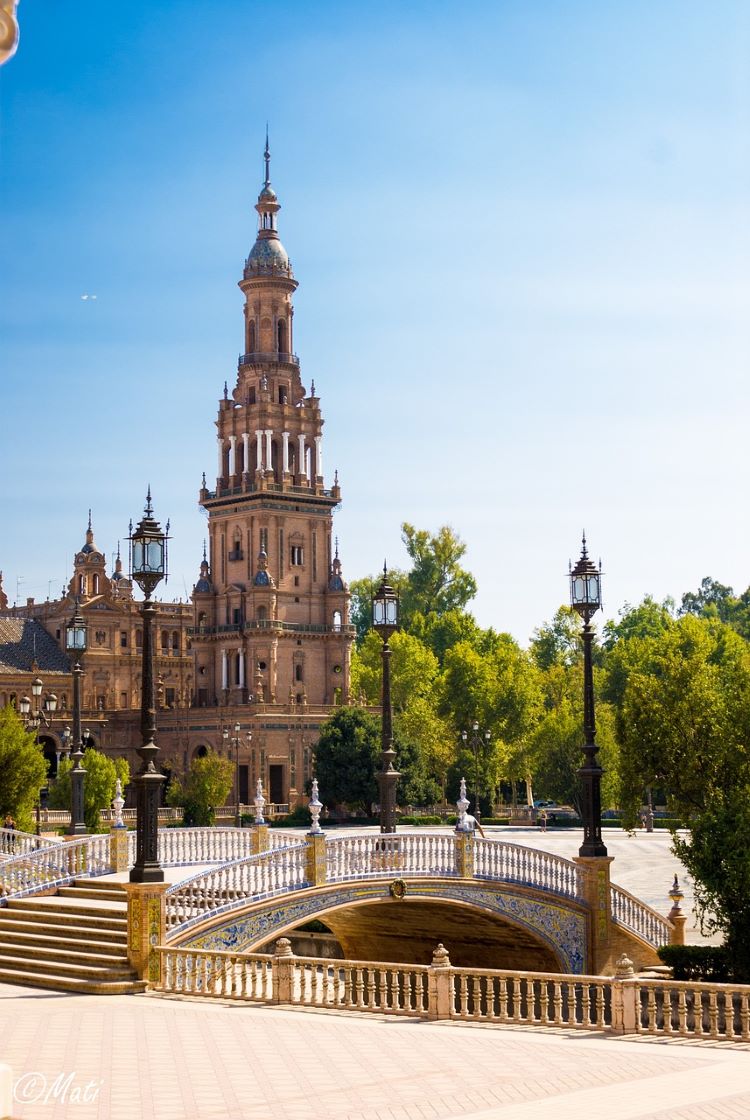
A little history about the Plaza de Espana in Seville
The Plaza de España in Seville, Spain, is a magnificent square that embodies the city’s rich history, architecture, and cultural heritage. Here’s a brief overview of its history:
Early Concepts and Construction (1914-1929): The idea of creating a grand square in Seville for the Ibero-American Exposition of 1929 took shape in the early 20th century. The event aimed to strengthen ties between Spain and its former colonies in the Americas. Annette Kellermann, a well-known Australian swimmer and actress, suggested the concept of the square, which was then developed by the Spanish architect Aníbal González. His vision was to create a monumental complex that showcased Spain’s historical, cultural, and artistic achievements.
Architectural Style and Design: Aníbal González combined various architectural styles in the design of Plaza de España, incorporating elements from Renaissance Revival, Moorish Revival, and Spanish Baroque styles. The square covers an area of around 50,000 square meters and is characterized by a crescent-shaped building with a semi-circular canal in front. Bridges cross the canal, connecting the building to a central island, forming a series of semi-circular arcades and galleries. The intricate tiles, bridges, and balustrades are adorned with colorful azulejos (ceramic tiles) that depict scenes from Spanish provinces, historical events, and legends.
Ibero-American Exposition of 1929: The Plaza de España gained international recognition during the Ibero-American Exposition of 1929. The event aimed to showcase Spain’s cultural ties with its former colonies and featured pavilions, exhibitions, and performances. The Plaza de España served as the centerpiece, embodying the grandeur of Spanish architecture and heritage. While the exposition had a significant impact, it also marked the end of the square’s initial purpose.
Subsequent Use and Renovation: After the exposition, the Plaza de España underwent periods of varying use and upkeep. During the Spanish Civil War, it was repurposed as a military barracks. Over the years, the square experienced periods of neglect and disrepair.
Restoration and Modern Use: In the late 20th century and early 21st century, efforts were made to restore and preserve the Plaza de España’s architectural beauty. It became a popular tourist destination, attracting visitors from around the world. The square’s distinct architecture also gained recognition through appearances in films, including the famous “Star Wars” movie, “Episode II: Attack of the Clones.”
Today, the Plaza de España stands as a symbol of Seville’s cultural heritage and architectural prowess. Its blend of historical elements, intricate tilework, and artistic representations continues to captivate visitors, offering a glimpse into Spain’s rich past and enduring creativity.
How to get to Plaza de Espana in Seville
Transportation Options
From Seville Airport
- Taxi: 15-20 minutes (approximately €25-30)
- Airport bus (EA) to city center + walk or local bus
- Airport bus to Santa Justa train station + metro to Prado de San Sebastián
By Public Transportation
- Metro: Line 1 to Prado de San Sebastián station (10-minute walk)
- City buses: Lines C1, C2, 34, or 37 stop near the plaza
- Tram: T1 line to Prado de San Sebastián
By Car
- Limited parking near the plaza
- Use parking garages in the city center
- Consider park-and-ride options at the outskirts
By Foot
- 20-minute walk from the Cathedral/Alcázar area
- Follow signs to Parque de María Luisa
- Enter through the park’s main entrance
Landmarks to Guide You
- The plaza is at the edge of María Luisa Park
- Look for the large semi-circular building with towers
- The University of Seville is nearby
- Archaeological Museum is adjacent to the plaza
Tips
- Most convenient entrance from Avenida de Portugal
- Best visited early morning or late afternoon to avoid crowds
- Allow time to explore the surrounding park
- Accessible for visitors with mobility issues
Plaza de Espana today
Today the Plaza de Espana is used for a variety of central government departments including the main town hall. Expansive verandas with arched columns create beautiful design and views of the courtyard. Along the main facades are plaza alcoves of wonderful tile work depicting regional provinces. Symbolic and ornate bridges representing the four ancient kingdoms of Spain cross over a crescent moat that mimics the shape of the Plaza de Espana.
Here are some more photo highlights of the plaza and detailed shots of the stunning craftsmanship involved:
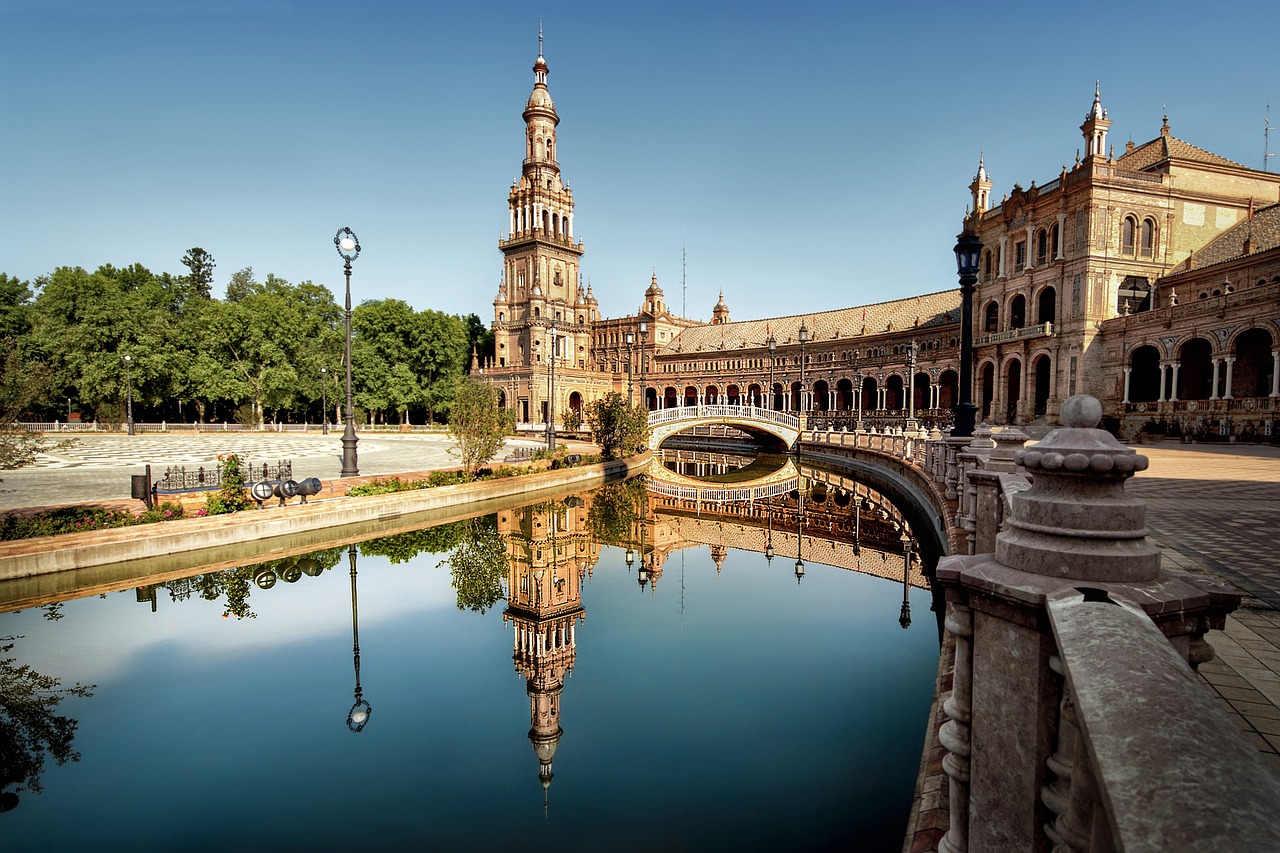
Azulejos and Architectural craftsmanship
The Plaza de España in Seville is a magnificent architectural wonder that seamlessly marries Spanish Renaissance and Moorish Revival styles. One of its most enchanting features is the extensive use of azulejos, intricately designed ceramic tiles that adorn its walls and benches. These azulejos depict scenes from Spain’s provinces, each showcasing unique local culture and heritage.
The azulejos are a riot of colors, forming vibrant mosaic-like compositions that tell stories through art. The tiles are carefully arranged to create captivating patterns and visual narratives that pay homage to Spain’s diverse regions. As you walk along the plaza’s semi-circular façade, you’ll be transported through a visual journey that encapsulates the essence of each province.
The architectural details of the Plaza de España are equally mesmerizing. The semi-circular building is bordered by a grand canal spanned by picturesque bridges, creating a reflective moat that adds to the ethereal beauty of the plaza. The façade boasts intricate stonework, towering columns, and decorative elements reminiscent of Spanish Renaissance architecture.
At the heart of the plaza stands a large fountain, which serves as a focal point surrounded by colorful flower beds. The central fountain complements the grandeur of the surrounding architecture while providing a serene space for visitors to gather and enjoy the ambiance.
Balconies and alcoves line the perimeter of the building, each featuring unique architectural flourishes. Arches, ornate balustrades, and decorative motifs combine to create an atmosphere of opulence and cultural richness. The spacious courtyard invites leisurely strolls and offers opportunities to interact with the artistic and historical significance of the space.
The Plaza de España stands as a testament to the intricate craftsmanship and artistic vision of its creators. It captures the spirit of Spain’s past while providing a vibrant and captivating backdrop for visitors to immerse themselves in the nation’s history and beauty. Whether appreciating the delicate artistry of azulejos or marveling at the architectural splendor, the Plaza de España is a truly enchanting experience.

Exploring the Symbolism of Azulejos at Plaza de España
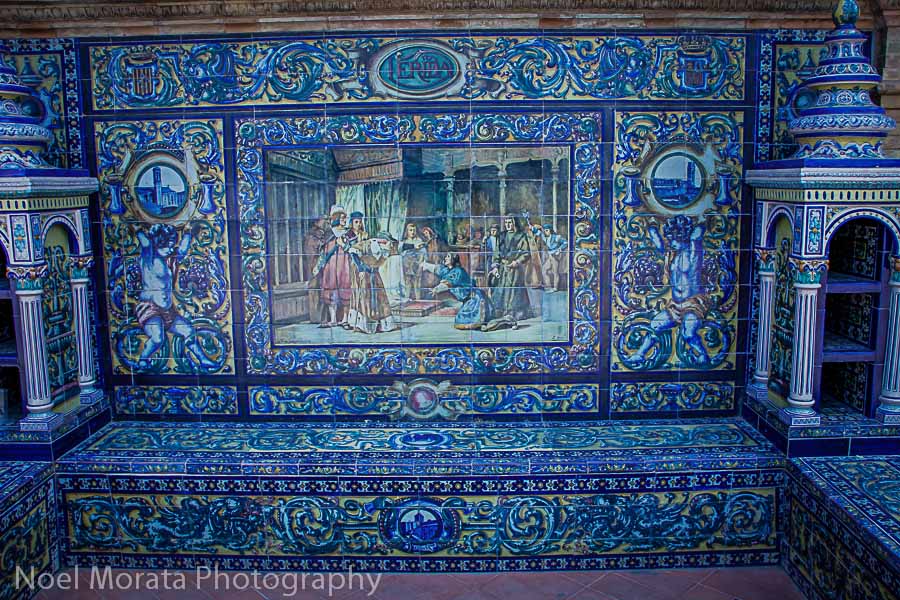
The azulejos at Plaza de España in Seville are more than just decorative elements; they tell a vivid story of Spain’s provinces and their unique cultural heritage. Each azulejo panel represents a different region, capturing the essence of Spain’s diversity and history. Let’s delve into the symbolism of these exquisite ceramic tiles:
Andalusia: Depicting flamenco dancers, horses, and the Alhambra, this panel encapsulates the vibrant spirit of Andalusia, a region renowned for its music, dance, and Moorish history.
Aragon: With images of the Basilica of Our Lady of the Pilar and historical figures, the Aragon panel honors the rich history and religious significance of this northern region.
Asturias: Represented by pastoral scenes, cider barrels, and the pre-Romanesque church of Santa María del Naranco, Asturias reflects its natural beauty and historic landmarks.
Balearic Islands: Sailboats, lighthouses, and Mallorcan architecture celebrate the maritime culture and coastal landscapes of the Balearic Islands.
Basque Country: Depicting traditional Basque sports and scenes from daily life, this panel captures the unique cultural identity and pride of the Basque people.
Canary Islands: Featuring native flora, indigenous people, and volcanic landscapes, this panel celebrates the diverse ecology and indigenous culture of the Canary Islands.
Cantabria: Showcasing a Roman bridge and the Cave of Altamira’s famous rock art, this panel pays homage to Cantabria’s ancient history and archaeological treasures.
Castilla-La Mancha: Depicting windmills, Don Quixote, and medieval castles, this panel embodies the literary and historical legacy of the region.
Castile and León: With Gothic cathedrals and historic castles, this panel highlights the architectural grandeur and religious importance of Castile and León.
Catalonia: Showcasing modernist architecture, Antoni Gaudí’s creations, and the region’s distinct culture, Catalonia’s panel reflects its artistic and innovative spirit.
Extremadura: Depicting conquistadors and the Guadalupe Monastery, this panel celebrates Extremadura’s role in Spain’s exploration and religious history.
Galicia: Featuring pilgrims on the Camino de Santiago and the Tower of Hercules, Galicia’s panel symbolizes its spiritual significance and maritime heritage.
All of the various regions of Spain are meticulously painted and represented magnificently in this impressive structure and gives you a more studied explanation and meaning to each area that is represented.
Weather and the best time to visit Seville, Spain
Seville, Spain, enjoys a Mediterranean climate with hot, dry summers and mild, wet winters. The city’s weather plays a significant role in determining the best time to visit for a comfortable and enjoyable experience.
Seasons:
Spring (March to May): Spring is often considered the best time to visit Seville. The weather is pleasantly warm with average temperatures ranging from 15°C to 25°C (59°F to 77°F). The city comes to life with colorful blossoms and various festivals, including the famous Semana Santa (Holy Week) and the April Fair.
Summer (June to August): Summers in Seville can be scorching, with temperatures often exceeding 30°C (86°F) and even reaching 40°C (104°F) or more during heatwaves. If you can tolerate the heat, you might find fewer crowds and some indoor attractions to escape the sun. However, outdoor activities can be challenging due to the high temperatures.
Fall (September to November): Fall is another great time to visit Seville. Temperatures begin to cool down from the summer highs, ranging between 18°C and 28°C (64°F to 82°F). The city remains lively with cultural events and festivals, making it a pleasant time to explore.
Winter (December to February): Winters in Seville are mild compared to many other European cities, with temperatures ranging from 8°C to 16°C (46°F to 61°F). However, it’s the wettest time of the year, and occasional rain showers can occur. Despite the rain, winter can be a good time to visit if you prefer fewer crowds and more budget-friendly options.
Best Time to Visit:
The best time to visit Seville depends on your preferences and tolerance for heat. Spring (March to May) and fall (September to November) are generally the most popular seasons due to the pleasant weather and vibrant cultural events. During these months, you can comfortably explore the city’s historic sites, enjoy outdoor activities, and experience its rich traditions.
If you’re willing to brave the heat, summer can offer a unique experience, especially if you plan your activities during the cooler parts of the day and take advantage of air-conditioned indoor spaces.
Winter can be a quieter time to visit, with fewer tourists and lower hotel prices. Just be prepared for occasional rain and cooler temperatures.
Ultimately, the best time to visit Seville depends on your preferred weather conditions and the type of activities you want to engage in during your stay.
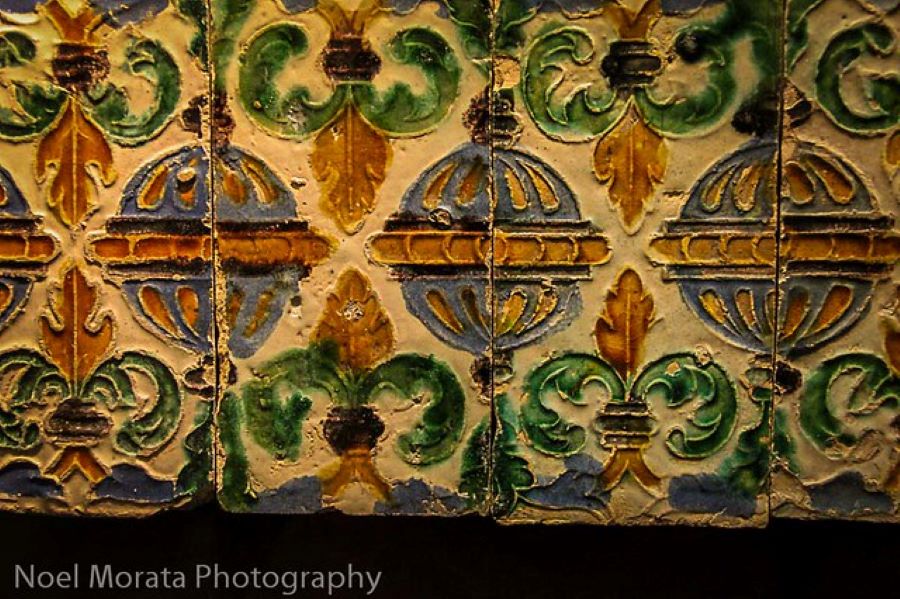
Nearby attractions close to Plaza de Espana
There are several attractions located near Plaza de España in Seville. Here are some of them:
Maria Luisa Park: Right next to Plaza de España, this expansive park is a beautiful place for a leisurely stroll, a relaxing picnic, or even renting a rowboat on the park’s central pond.
Royal Alcazar of Seville: A stunning palace complex known for its intricate architecture, beautiful gardens, and historical significance. It’s just a short walk from Plaza de España.
Seville Cathedral: One of the largest Gothic cathedrals in the world, known for its impressive architecture, the tomb of Christopher Columbus, and its towering Giralda bell tower.
Archivo de Indias: This historical building houses valuable documents related to the Spanish colonies in the Americas. It’s a UNESCO World Heritage Site and is located adjacent to Seville Cathedral.
Barrio Santa Cruz: This charming historic neighborhood is known for its narrow streets, vibrant squares, and traditional Andalusian architecture. It’s a great place for exploring shops, cafes, and local culture.
Torre del Oro: A historic tower located on the Guadalquivir River, offering panoramic views of the city. It’s a short walk from Plaza de España and provides insights into Seville’s maritime history.
Plaza de America: This square is situated near Plaza de España and features beautiful gardens, fountains, and several impressive buildings that house various museums.
Palacio de San Telmo: A stunning baroque palace that serves as the seat of the President of the Andalusian Government. It’s located along the riverbank not far from Plaza de España.
Seville Aquarium: A family-friendly attraction where you can explore marine life and various aquatic environments.
Museum of Arts and Popular Traditions: Located within Maria Luisa Park, this museum offers insights into Andalusian culture and traditions.
These attractions provide a diverse range of experiences, from historical and architectural wonders to relaxing parks and cultural sites. Whether you’re interested in history, art, or simply enjoying the beauty of the city, there’s something for everyone near Plaza de España.
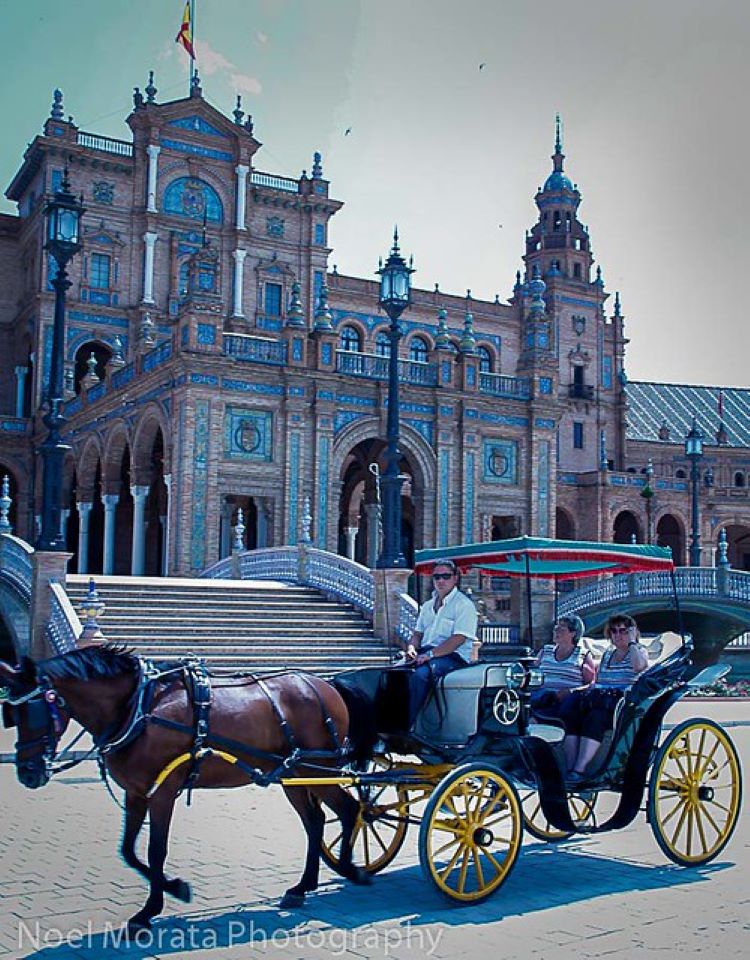
Check out these other posts to visiting Seville
Did you enjoy visiting Plaza de Espana in Seville, if so, here are some other posts I’ve done recently about Seville.
Discovering Seville – a highlight tour
Game of Thrones at the Alcazar, Seville
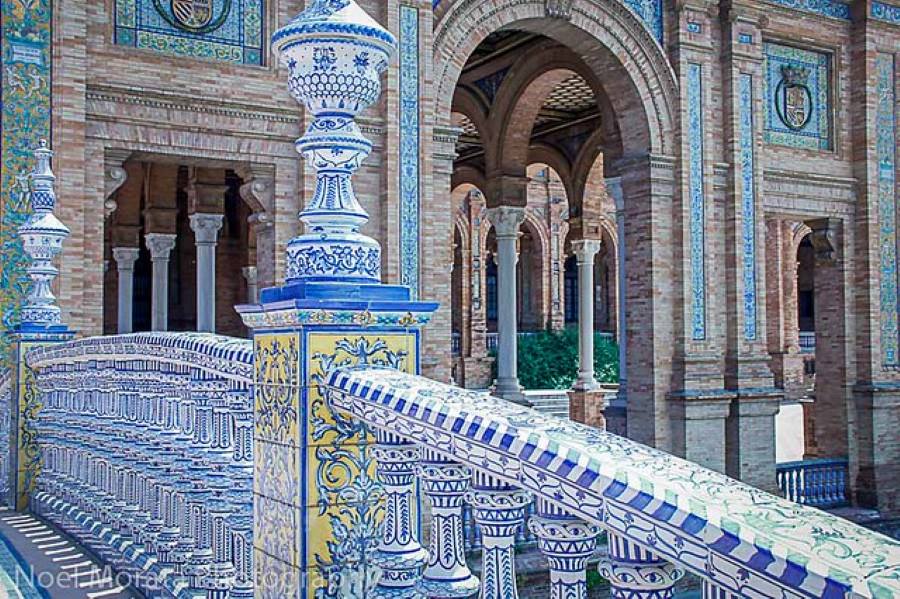
Conclusion to Plaza de Espana, Seville
Located in the heart of Seville, Plaza de España is a stunning mosaic of history and artistry. Born from the Ibero-American Exposition of 1929, it’s a masterpiece by architect Aníbal González, blending styles like a time-traveling tapestry. The crescent square cradles a canal, its tiles telling tales of Spain’s past. Beyond an expo center, it’s a living canvas through seasons – spring’s vibrancy, summer’s heat, autumn’s charm, and winter’s calm. A place where past and present dance, Plaza de España is Seville’s living, breathing enchantment.
To learn more about Plaza de Espana, visit this site.
Thanks for checking out this post on Plaza de Espania, Seville with Visiting Spain and Mediterranean.com, hope that this was helpful for planning a visit with things to do, attractions and other fun places to explore. Please come back again for more adventures in Spain and the Mediterranean coast.
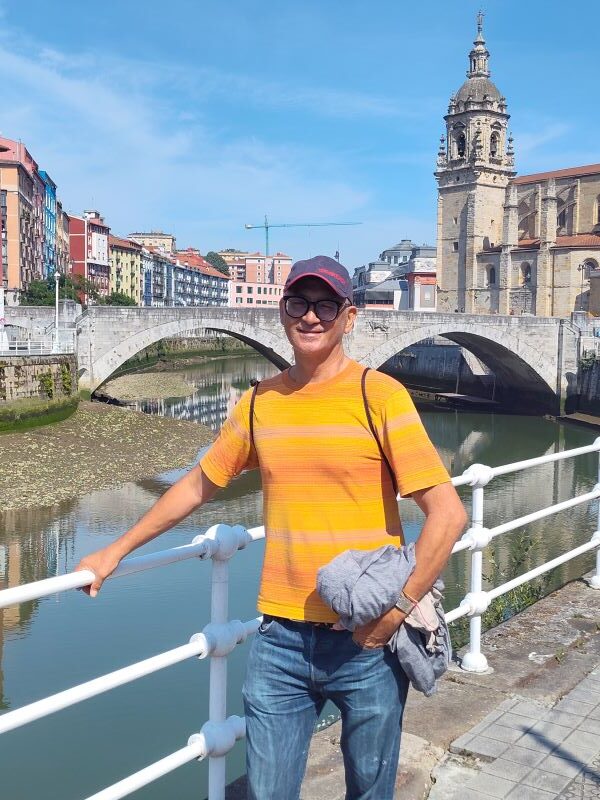
About author – Noel Morata
After relocating from the United States to Andalusia in 2020, I’ve made it my mission to discover every corner of Spain. Based just east of Granada, I’ve spent over 12 months exploring Catalonia province and the rest of Spain, including multiple extended visits to Barcelona throughout different seasons. My background in Spanish cultural studies and years of residence and exploring all of Spain have given me unique insight into the region’s historical significance, local customs, and culinary traditions.
I regularly update my guides with the latest information gathered through personal visits and relationships with local tourism officials, always seeking what’s new and exciting in each destination. As a self-proclaimed foodie, I’m passionate about discovering authentic local markets and regional specialties.
A painted ceramics enthusiast and artist, I love this landmark and share the history, artisit influence, development and details that make up this massive structure dedicated to the whole of Spain and stunning art and craftsmanship combined.

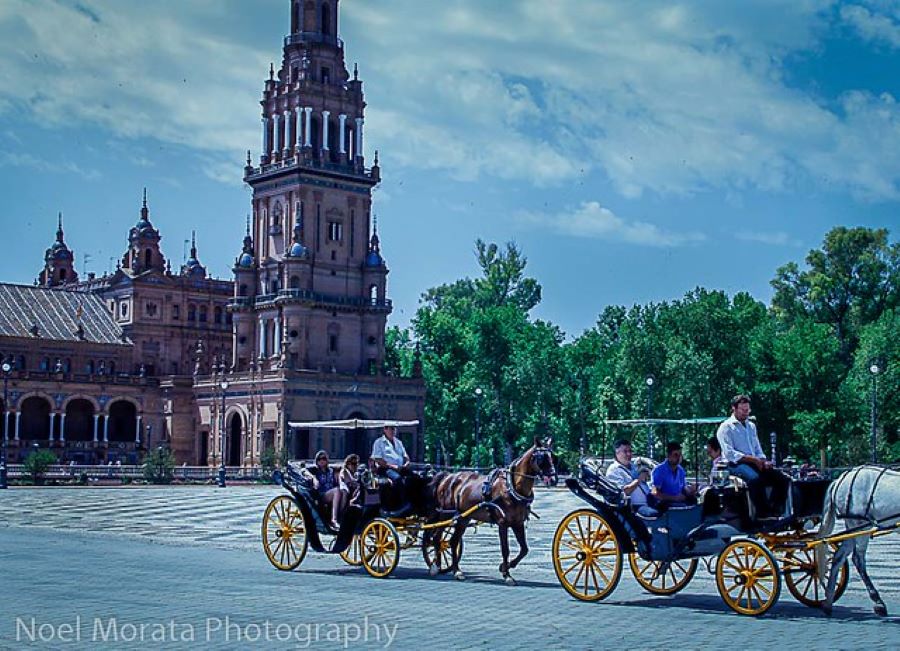
4 thoughts on “Plaza de Espana Seville”